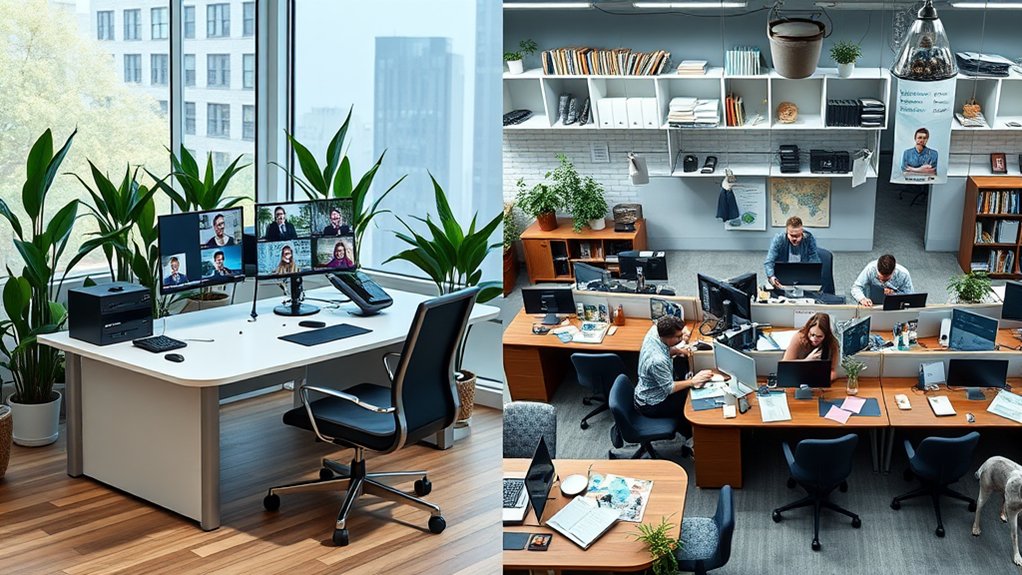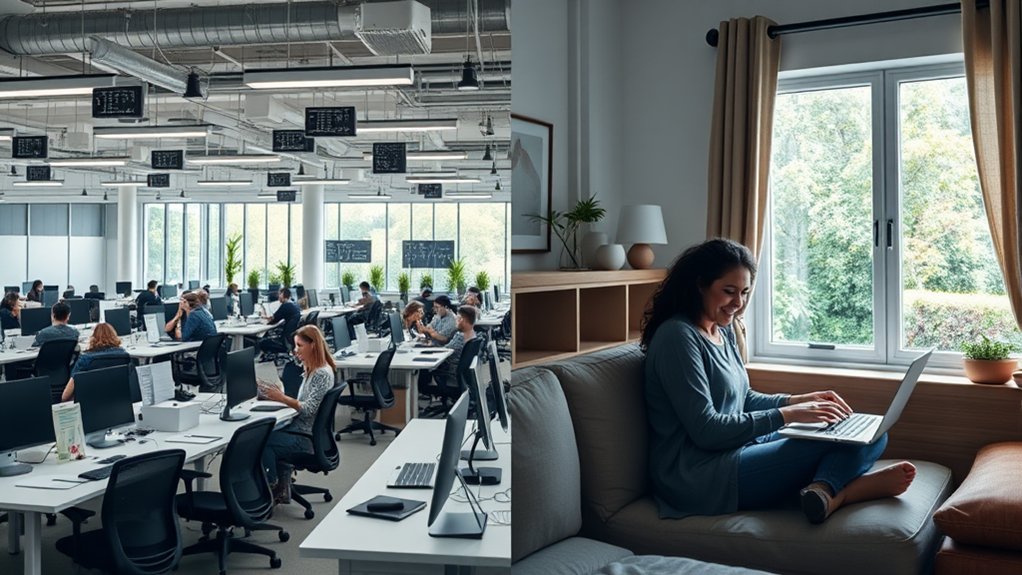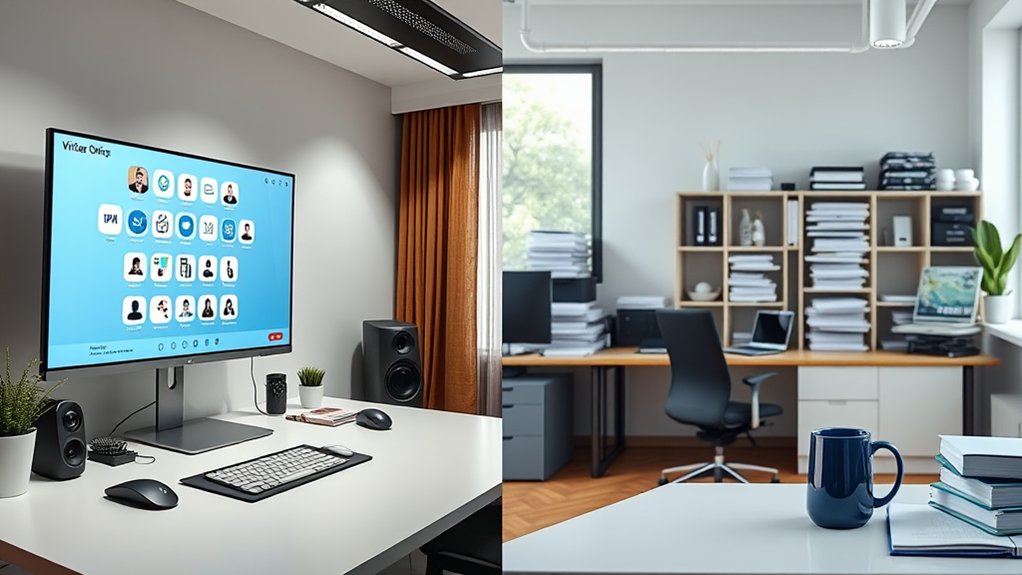The fundamental difference between a virtual office and a physical office resides in their operational frameworks and spatial requirements. A virtual office offers essential business functionalities—such as a professional address, mail handling, and meeting room access—without necessitating a physical workspace, thereby enhancing cost-efficiency and flexibility. Alternatively, a physical office serves as a dedicated environment for employees to collaborate and innovate, fostering immediate interaction and a structured work atmosphere. While virtual offices promote remote collaboration and diverse talent acquisition, physical spaces strengthen client relations through direct engagement, ultimately shaping your business's credibility and image. Uncover additional insights to enhance your decision-making process.
What Is a Virtual Office?

A virtual office is a modern solution that gives you a legitimate business address for registration and correspondence without the need for a physical workspace. By utilizing virtual office services, you can guarantee that your business communications remain professional while safeguarding your privacy by not using your home address. These services often include mail forwarding, phone answering, and access to meeting rooms, all tailored to your needs. As a cost-effective option for startups and remote working entrepreneurs, virtual offices typically charge between $50 and $300 monthly, considerably less than traditional office rentals. With such flexibility, you can hire talent from a global pool, empowering your business to thrive regardless of location constraints.
What Is a Physical Office?
A physical office serves as a dedicated workspace where employees engage in their daily tasks, fostering an environment tailored for collaboration. This structured setting enhances communication and teamwork, allowing for in-person interactions that can lead to innovative solutions and stronger relationships among colleagues. However, while it provides significant benefits, it also entails higher operational costs that can influence your overall budget. Additionally, renting a physical office in Dubai can be a complex process due to navigating complex regulations that require careful consideration and planning.
Workspace Environment Dynamics
When you think about a physical office, envision a dedicated space where employees can collaborate, complete tasks, and build relationships. This traditional physical workplace fosters a vibrant workspace culture, promoting interaction that virtual offices simply can't replicate. The structured environment minimizes distractions, enhancing focus and productivity. Furthermore, face-to-face interactions can spark creativity and innovation, essential for team synergy. However, operating a physical office comes with significant overhead costs—ranging from $2,000 to over $10,000 monthly—based on location and size. This investment can bolster a company's credibility and visibility, as clients appreciate the opportunity to engage directly with the organization. Ultimately, the dynamics within a physical workspace can profoundly influence employee performance and overall organizational success. Additionally, having a physical office can enhance strategic planning by providing a stable environment for team collaboration and decision-making.
Employee Collaboration Opportunities
Physical offices create an environment where employees can easily collaborate, making teamwork more effective and spontaneous. In-person interactions foster immediate feedback and enhance non-verbal communication, which are essential for productive discussions. The structured setting of a physical office space allows team members to utilize specialized equipment and resources that might not be accessible remotely, further enriching collaborative projects. Additionally, the presence of colleagues strengthens company culture and fosters a sense of community, enhancing employee collaboration opportunities. Physical offices also facilitate team-building activities, promoting engagement and satisfaction among employees. Furthermore, having a physical office can enhance business setup solutions by providing a centralized location for operations and client interactions.
| Collaboration Aspect | Benefits | Impact on Team Members |
|---|---|---|
| Face-to-Face Meetings | Immediate feedback | Quicker decision-making |
| Structured Environment | Access to specialized resources | Enhanced project efficiency |
| Team-Building Events | Strengthened relationships | Increased morale and retention |
| Spontaneous Interactions | Boosted creativity | Improved problem-solving |
Key Differences Between Offices

When weighing the differences between virtual and physical offices, you'll notice significant contrasts in cost and flexibility. Virtual offices typically offer lower monthly expenses while enabling adaptable work arrangements, allowing you to scale your operations more easily. Conversely, physical spaces foster structured collaboration but often come with higher financial commitments and less flexibility in staffing and location.
Cost and Financial Impact
Virtual offices can save you a significant amount of money compared to traditional office spaces. With monthly costs ranging from $50 to $300, virtual setups allow you to minimize costs substantially, especially when compared to physical offices that often exceed $1,000 per month. The absence of expenses related to rent, utilities, and maintenance can lead to overall savings of up to 30%. Moreover, while virtual offices provide essential services like mail handling and call answering, physical presence incurs additional costs such as insurance and regular upkeep. Additionally, opting for a virtual office reduces employee commuting costs, enhancing your financial efficiency. By eliminating the financial burden of long-term leases, you can more readily adapt your business to changing market demands.
Flexibility and Scalability Options
While cost savings play a significant role in choosing between virtual and physical office spaces, flexibility and scalability are equally important factors. Virtual offices empower you to scale operations swiftly, unencumbered by the constraints of long-term leases associated with physical spaces. This adaptability allows you to tap into a global talent pool and hire remotely, minimizing relocation expenses. Additionally, the inherent flexibility of virtual offices enables you to explore new markets without the commitment of a physical presence, facilitating strategic pivots as necessary. Unlike physical offices, which often impose fixed schedules, virtual setups support flexible working hours, enhancing employee satisfaction. Furthermore, businesses in Dubai can benefit from the advantages of UAE Free Trade Zones, ensuring access to a business-friendly environment. Ultimately, businesses leveraging virtual offices can seamlessly adjust services and scale operations according to fluctuating demand, ensuring ideal resource utilization.
Cost and Financial Considerations
Choosing between a virtual office and a physical space often comes down to cost and financial considerations. A virtual office typically incurs monthly costs ranging from $50 to $300, in stark contrast to physical spaces that can exceed $1,000, depending on location and size. By opting for a virtual setup, you can save up to 30% on overhead costs, as you eliminate expenses related to rent, utilities, and maintenance. Meeting room rentals in virtual offices generally range between $20 to $50 per hour, providing necessary flexibility without a permanent lease. Additionally, virtual offices enable businesses to scale operations without the financial burden of expanding physical space, making them particularly appealing for startups and cost-conscious entrepreneurs aiming to optimize their expenditures.
Flexibility and Adaptability

When it comes to flexibility and adaptability, a virtual office stands out by allowing you to scale operations effortlessly and tap into a global talent pool. Unlike physical offices, which often impose long-term leases that hinder adaptability, virtual offices empower you to swiftly adjust to market fluctuations and workforce needs. This flexibility supports various working arrangements, such as remote or hybrid models, catering to employee preferences and enhancing overall job satisfaction. Additionally, shifting to a virtual office eliminates the financial burden of physical relocations, facilitating market testing without substantial commitments. Ultimately, virtual offices enable rapid modifications to your business structure, making it easier to increase or decrease services and staff, a capability less feasible in traditional office environments.
Collaboration and Communication
The flexibility of virtual offices enhances collaboration and communication, but it also presents unique challenges. In a virtual environment, you rely heavily on digital tools, which can broaden global collaboration opportunities, yet may lack the immediacy of face-to-face interactions common in physical offices. While physical spaces facilitate spontaneous discussions and quick brainstorming sessions, virtual offices necessitate intentional efforts to maintain engagement through scheduled meetings and team-building activities. Additionally, studies indicate that employees in physical settings often face fewer distractions, allowing for improved focus during collaborative tasks. Although virtual offices can offer occasional in-person meetings through rented spaces, they may struggle to replicate the consistent environment of physical offices, which naturally promote collaboration and enhance business professionalism.
Client Interaction Dynamics

While both virtual and physical offices offer unique advantages for client interactions, the dynamics of these engagements can notably impact relationship building. In a physical office, face-to-face meetings cultivate a stronger professional presence, allowing clients to experience your company culture firsthand. This direct interaction often enhances trust and credibility. Conversely, virtual offices may facilitate client meetings through booked meeting rooms, yet they can lack the personal touch that fosters deeper connections. Miscommunication can arise from remote communication tools without the context of physical presence. Adopting a hybrid approach allows you to strategically balance in-person meetings with routine virtual interactions, optimizing engagement and efficiency while maintaining meaningful client relationships. Ultimately, the method you choose can notably influence client perceptions and satisfaction.
Business Image and Credibility
Building strong client relationships goes hand-in-hand with establishing a solid business image and credibility. Here's how a virtual office can enhance your professional perception:
- Legitimate Business Address: It provides a recognized address, boosting your credibility without needing a physical space.
- Legal Compliance: A registered address aids in legal and tax matters, enhancing your business image among stakeholders.
- Professional Services: Access to meeting rooms and reception services allows you to maintain a professional image, bridging virtual and in-person interactions.
- Local Visibility: While physical offices offer immediate recognition, a virtual office can still attract clients who prioritize professionalism.
Ultimately, the choice between virtual and physical spaces affects how your business is perceived, influencing your overall credibility in the market.
Choosing the Right Option

How do you decide between a virtual office and a physical space? Begin by evaluating the cost; virtual offices typically range from $50 to $300 monthly, while physical spaces can exceed $1,000, depending on location and size. Next, assess your business needs: virtual offices offer flexibility and lower overhead, ideal for startups and remote teams, whereas physical offices encourage face-to-face collaboration. Consider your company image; a physical office may enhance your credibility in client interactions, while a virtual setup could necessitate occasional in-person meetings to establish trust. Finally, think about scalability; virtual offices allow for rapid adaptation to growth without the constraints of long-term leases, providing a significant advantage in today's dynamic business landscape.
Frequently Asked Questions
What Is the Difference Between Physical and Virtual Offices?
When considering physical and virtual offices, you'll find remote collaboration tools enhance workspace flexibility. Virtual offices offer cost efficiency, while physical spaces provide in-person interaction, each catering to different business needs and preferences.
What Is the Difference Between Virtual Office and Office Space?
So, you want to know about virtual offices versus office space? Think remote collaboration tools, flexible working arrangements, and cost-effective solutions. One's a digital dream, the other's a brick-and-mortar reality. Choose your adventure wisely!
What Is Physical Workplace Vs Virtual Workplace?
When considering physical versus virtual workplaces, you'll find remote collaboration tools enhance connections. Analyzing employee productivity metrics and conducting cost effectiveness analysis can help you determine which setup best suits your business goals and team dynamics.
What Does Virtual Office Mean?
A virtual office means you can establish a professional presence without a physical space, leveraging remote communication and flexible work options. You'll enjoy significant cost savings while maintaining privacy and efficiency for your business operations.
Conclusion
In traversing the landscape of modern business, choosing between a virtual office and a physical space is akin to selecting a path through a dense forest. Each option presents unique advantages and challenges, influencing your operational efficacy and client relationships. By weighing cost, flexibility, and image, you can forge a strategic direction that aligns with your organizational goals. Ultimately, the right choice will illuminate your path, fostering growth while ensuring that your business adapts seamlessly to an evolving marketplace.



